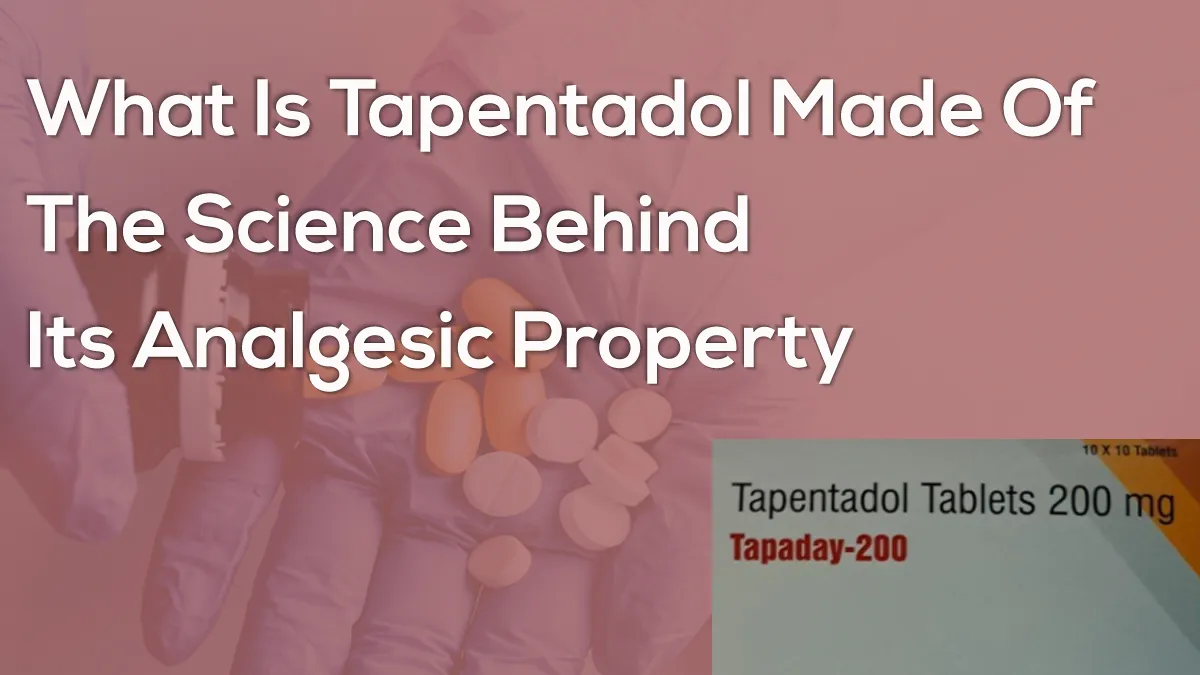The Tapentadol brand drugs are formulated with Tapentadol Hydrocholrode as the active compound, along with other inactive compounds that are present, to allow disintegration of the tablet after its administration and to make it more stable.
Tapentadol is an effective and unique pain medication with a dual mechanism of action. Its fast action and ability to manage both acute and chronic pain make it a pharmaceutical wonder. However, to truly understand the efficacy and benefits of Tapentadol, it is important to delve into its composition or list of ingredients that confer its potency.
In this blog, we look into the composition of tapentadol, further shedding light on the science behind Its therapeutic success.
An Overview Of Tapentadol Hydrochloride- The Active Ingredient
Tapentadol Hydrochloride (3-((1R,2R)-3-(dimethylamino)-1-ethyl-2-methylpropyl) phenol hydrochloride) is a non-racemic molecule, a substance where the molecules are not an equal mix of two mirror-image forms. Its molecular formula is C14H23NO.HCl [1].
Tapentadol tablets, also known as the orange pain pill due to their physical characteristics, are the first agent of a new class of drug (MOR-NRI) that combines two mechanisms of action, namely noradrenaline reuptake inhibition (NRI) and µ-opioid receptor (MOR) agonism.
The brand drugs of Tapentadol, including Nucynta, Palexia, and Aspadol, are also formulated with the same active compound, thus showcasing similar efficacy and clinical benefits.
The drug strength expresses the concentration of the active ingredient present in the formulation. For example, 100 mg of Aspadol is formulated with 100 mg of Tapentadol Hydrochloride.
Inactive Compounds of Tapentadol Immediate Release Tablets
Apart from the active ingredient, the other ingredients that are present in the Tapentadol are listed below.
Microcrystalline Cellulose
It is used as a binder in oral tablets and capsules, thus helping to hold the other ingredients in the tablet together. It also helps in promoting the hardness of the pill, thus preventing it from falling apart [2].
Lactose Monohydrate
It is a form of milk sugar that is commonly used as a filler in medications. It also acts as a stabilizer and is considered safe, with no possible side effects in lactose-intolerant patients [3].
Croscarmellose Sodium
It is a commonly used pharmaceutical excipient that plays a crucial role in the disintegration of tablets, the process of breakdown of a medication upon ingestion. It facilitates quick disintegration, thus contributing to improved bioavailability of the drug.
Povidone K30
The Povidone K30 is a polymer, a large molecule that is made up of many smaller identical molecule that acts as a binder in tablets and capsules. It is commonly used in the pharmaceutical industry due to its high solubility in both water and other solvents.
Magnesium Stearate
Magnesium stearate is a key compound used in the formulation of tablets that helps in forming a thin film around the particles needed for the disintegration of the tablet in water. It also facilitates better absorption of other compounds present in the tablet.
Inactive Compounds Of Extended-Release Formulation
The extended-release formula of Tapentadol (Nucynta or Aspadol ER) is formulated with other inactive ingridients as listed below.
Alpha-tocopherol (vitamin E), hypromellose, polyethylene glycol, and polyethylene oxide.
The film coating of the ER tablets is comprised of titanium dioxide, polyvinyl alcohol, talc, polyethylene glycol, and colorant FD&C Blue #2 aluminum lake is used for 100, 150, 200, and 250 mg strengths; and yellow iron oxide is used in 150 mg tablets.
The printing inks used to emboss on the tablets contain propylene glycol and shellac glaze for all strengths. However, black iron oxide (50, 100, 150, and 200 mg tablets) or titanium dioxide (250 mg tablets) is used.
Development And Synthesis Of Tapentadol
Tapentadol Hydrochloride was invented by a German pharmaceutical company named Grünenthal in the late 1980s, led by Helmut Buschmann while analyzing the activity and chemistry of Tramadol. Using Tramadol as a reference, his team aimed to discover a single molecule with a better safety profile and activity, thus resulting in the formation of Tapentadol.
In 2003, Grünenthal partnered with two Johnson & Johnson subsidiaries, i.e., Ortho-McNeil Pharmaceutical and Johnson & Johnson Pharmaceutical Research and Development, to develop and market Tapentadol tablets. Johnson & Johnson had the exclusive rights to sell this opioid pain medication in the US, Canada, and Japan. Thus, Tapentadol was first synthesized in the USA and marketed by Ortho-McNeil-Janssen Pharmaceuticals under the brand name Nucynta. However, in 2010, Grünenthal Pharmaceuticals granted Johnson & Johnson the right to market Tapentadol in 80 additional countries.
At the same time, Grünenthal had rights elsewhere and marketed the Tapentadol under the brand name of Palexia.
Shelf Life Of Tapentadol And Storage Condition
The expiration date of Tapentadol brand drugs is 24 months.
Tapentadol must be stored at 25° C (77° F) with excursions from 15° to 30°C (59° 86°F). It should be kept well in a closed container away from the reach of pets and children.
Ensure the medication is placed away from moisture, direct light, and heat.
Our Final Thoughts On The Composition Of Tapentadol
Tapentadol is not currently available as a generic tablet and is retailed only as a brand medication. Nucynta is the most common Tapentadol brand available in the USA, whereas Aspadol tablets are the most affordable option. These Brand drugs are formulated with Tapentadol Hydrochloride as its active compound, which is present in correspondence to its strength.
It contains a few other inactive compounds that are present for its disintegration in the body and maintaining the stability of the tablet.

